Menus
- The R 80 G / S and the R 1200 GS in direct comparison
- BMW R 80 G / S and BMW R 1200 GS: Part 2
- BMW R 80 G / S
- BMW R 1200 GS
- Opinion BMW R 80 G / S versus R 1200 GS
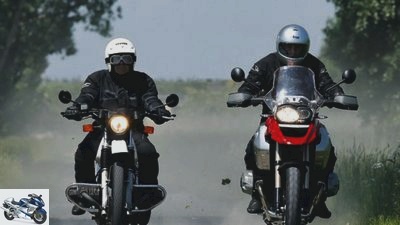
Frank Herzog
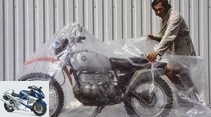
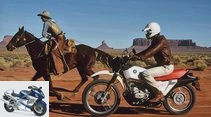
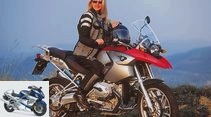
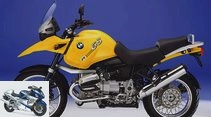
71 photos

BMW
1/71
1985: Little Gaston Rahier fights his way through the desert again with his huge HPN boxer and can successfully defend his title at the Dakar.
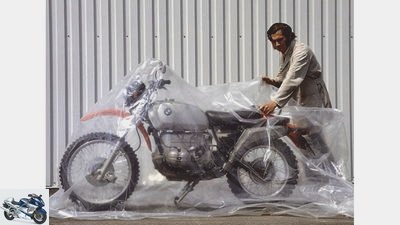
BMW
2/71
1979: The first prototype of the new series is shown.
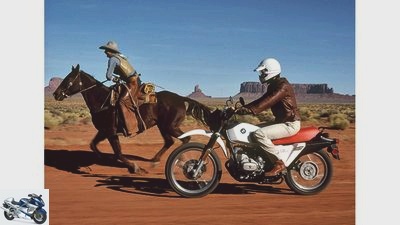
BMW
3/71
A future motorcycle monument in Monument Valley.
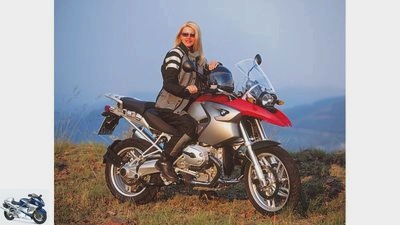
BMW
4/71
A modernized 1200 boxer engine that has been boosted to 100 hp makes its debut. It is significantly lighter, has a balancer shaft and knock control.

BMW
5/71
R 1150 GS.
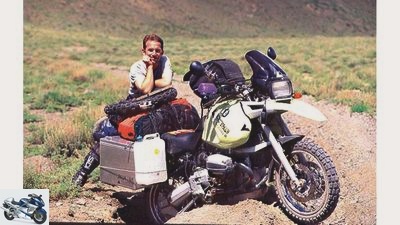
Schroder
6/71
1997: MOTORRAD editor Michael Schroder got stuck with the R 1100 GS in the Gobi desert due to clutch damage. His bike was stolen and found in a battered state a year later.

BMW
7/71
1984: World champion in motocross, now hero at the Dakar: Gaston Rahier wins on a 75 hp 1000cc. BMW silvered the rally success with the special model R 80 G / S ?? Paris-Dakar ??.
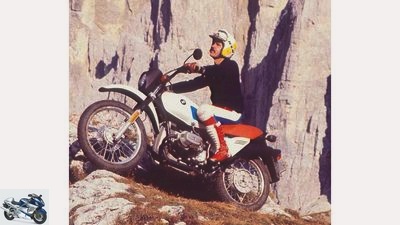
BMW
8/71
What a success!
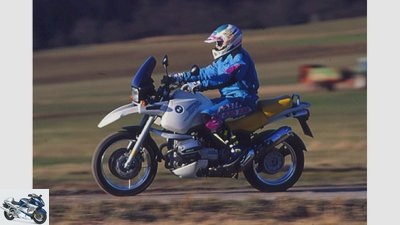
9/71
1994: With four valves and injection, the GS series with 850 and 1100 cubic capacity started technically into the modern era in 1994.

BMW
10/71
R 80 G / S in off-road use.
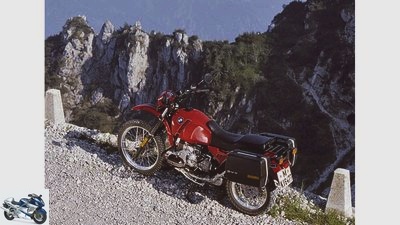
BMW
11/71
1988: R 80 GS.
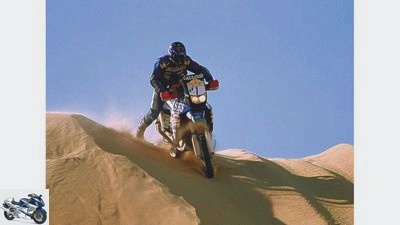
BMW
12/71
2000: a great result ?? BMW took the first four places at the Dakar, three of them with the single-cylinder F 650, including winner Richard Sainct. The American Jimmy Lewis finished third with his HPN-tuned R 900 RR.
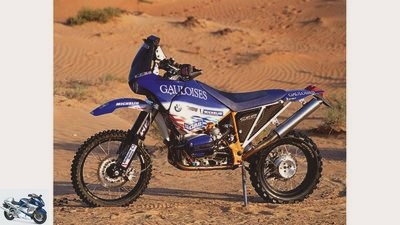
BMW
13/71
Factory racer R 1150 GS / RR at the Dakar Rally 2000.
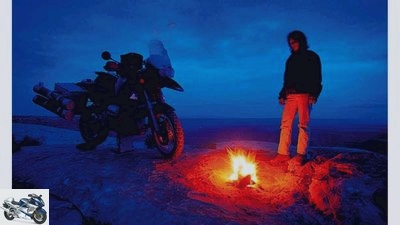
Martin
14/71
1999: Michael Martin and his girlfriend start an ambitious project: across all the deserts of this earth. His means of transport: a fully packed BMW R 1150 GS ?? what else?
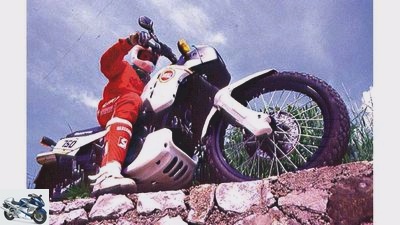
15/71
1985: The Italians are also involved in rallying and bring the Cagiva 650 Elefant, which costs 12,390 marks. Five hundred marks more expensive
as a BMW, with a cultivated Ducati engine, from 1987 as a 750.
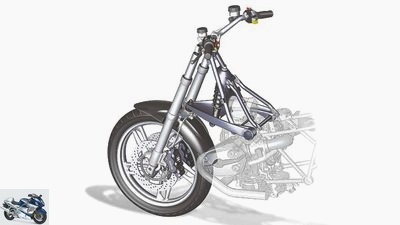
Drawing: BMW
16/71
The Telelever is a synthesis of swingarm and telescopic fork – fork legs without damper elements, but with a central spring strut on the wishbone.
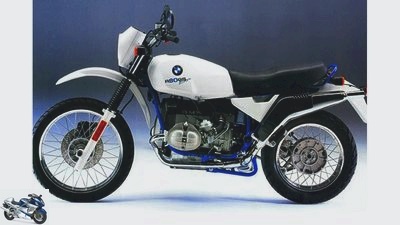
BMW
17/71
The 800? Basic ?? (until 1997) was the last two-valve GS.
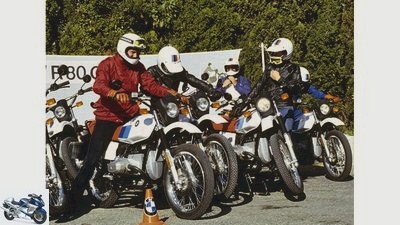
BMW
18/71
1980: The development team needed only one year and nine months from the start of the project to the official press presentation of the R 80 G / S on September 1, 1980 in Avignon, France.
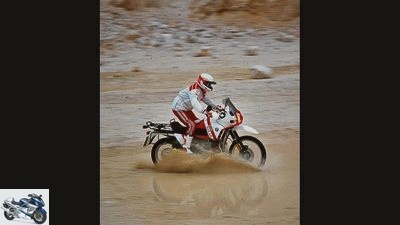
BMW
19/71
1989: special model "Paris-Dakar" the R 100 GS.
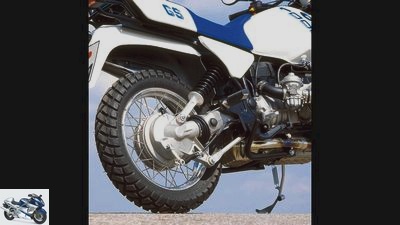
BMW
20/71
BMW is further developing the characteristic cardan drive. The patented Paralever rear swing arm of the new R 80/100 GS generation reduces load change reactions.
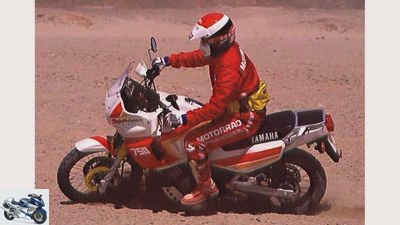
Yamaha
21/71
1989: Yamaha, trendsetter in the enduro sector, slept through the two-cylinder segment. The 69 hp Yamaha XTZ 750 Super Tenere does nothing to change that, and it soon disappears into oblivion.
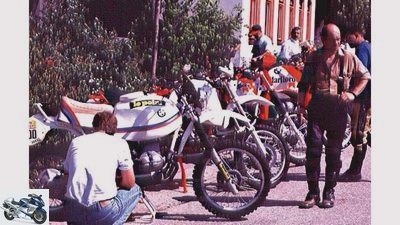
Johann
22/71
2000: 270 GS riders come to the MOTORRAD meeting on the occasion of the GS’s 20th anniversary: to celebrate, chat and be amazed ?? about the machine of the Paris-Dakar winner of 1981/83, Hubert Auriol.
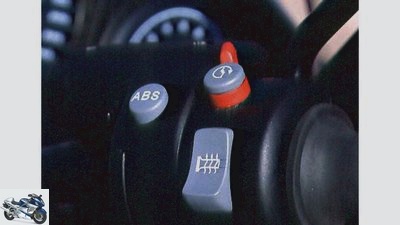
Gargolov
23/71
2003 ABS is optional equipment for the R 1150 GS, and almost every buyer in Germany orders it. Now a new ABS variant, the integral ABS with electric brake booster, is replacing the previous ABS II.
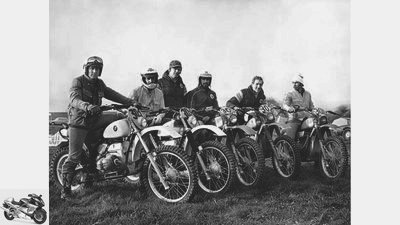
BMW
24/71
1979: After a decade of restraint, BMW returns to off-road racing with a works team and wins the German championship with Richard Schalber in 1979.
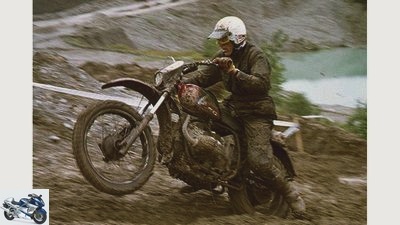
25/71
Sports forerunner: Factory enduros took part in international races as early as the 1960s and 1970s. In the picture: Herbert Schek at the Enduro European Championship 1978.
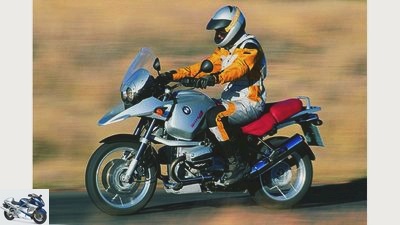
26/71
1999: Technically based on the 1100, the R 1150 GS with 85 had five more horsepower.
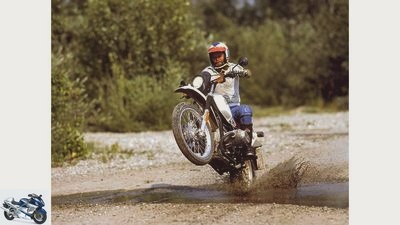
BMW
27/71
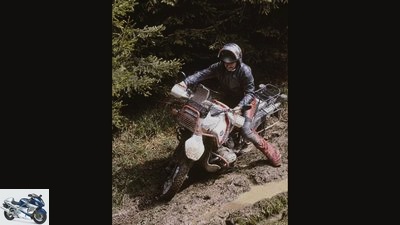
BMW
28/71
1990: R 100 GS Paris-Dakar during driver training.
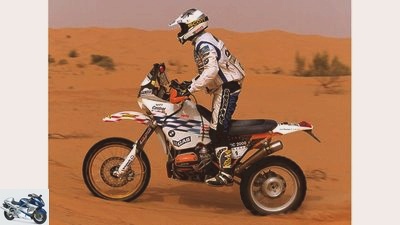
BMW
29/71
1999: Oscar Gallardo at the Tunisia rally on the BMW R 1100 GS / RR.

30/71
1990: The R 65 GS is not a bestseller. Here is a machine with an unusual paint job, the 27 hp bike is part of the THW Franken motorcycle squad.
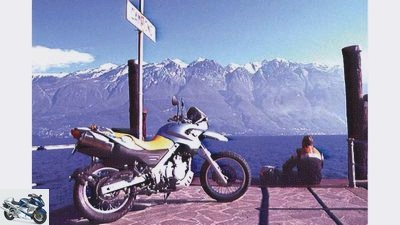
Artist
31/71
2000: With the relocation of production from Italy to Berlin, the single-cylinder Enduro F 650 was finally given the nickname GS, received injection and G-Kat, and its design was based on the R 1150 GS.
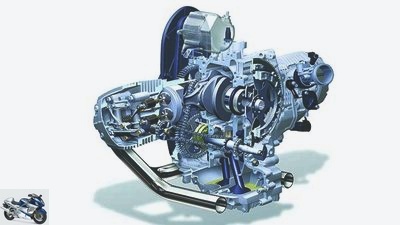
Drawing: BMW
32/71
The completely renovated 1200 engine with balance shaft.
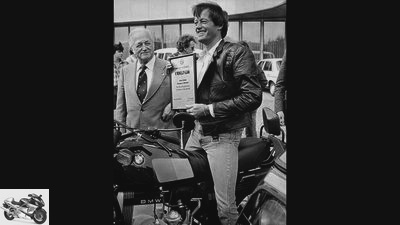
BMW
33/71
1982: Peter Fonda, movie hero through ?? Easy Rider ??, receives the certificate ?? The man who campaigned for freedom on two wheels ?? and becomes an honorary member of the BMW Club Europa e.V.
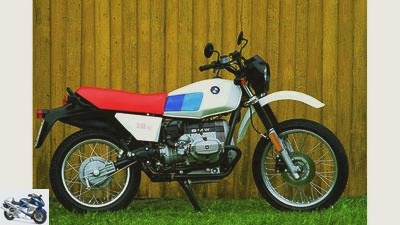
BMW
34/71
The sales success of the R 80 G / S (over 20,000 units) ensured the continued existence of BMW-Motorrad.
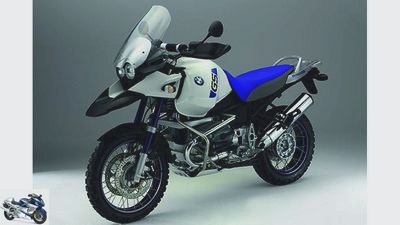
BMW
35/71
2002: To this day, BMW offers the 1150 in addition to the 1200, namely in the adventure trim (e.g. fat tank).
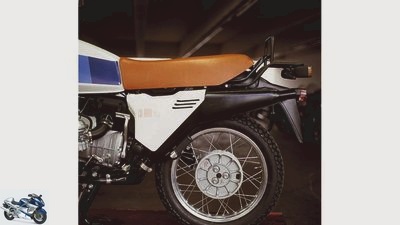
BMW
36/71
Monolever of G / S.
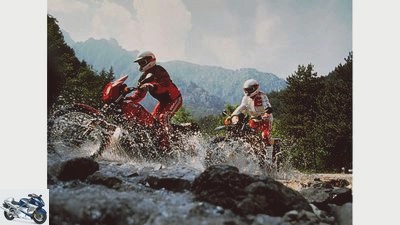
BMW
37/71
R 80 and R 100 GS when leaving together.
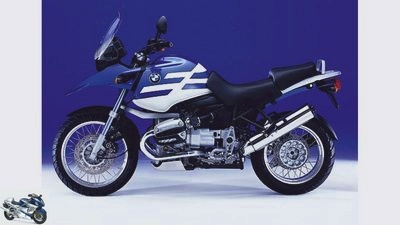
BMW
38/71
R 1150 GS.
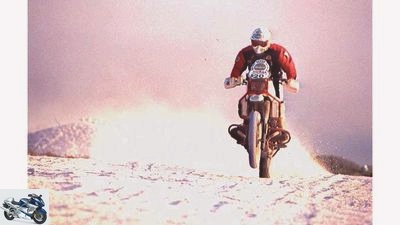
39/71
1992: BMW engineer Jutta Kleinschmidt finishes the Paris-Cape Town Rallye with a broken foot, but as the fastest woman on a near-series R 100 GS
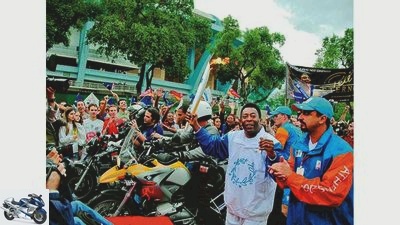
BMW
40/71
2004: TV teams also rely on BMW GS, as here at the Athens Olympics. Next to it a prominent torchbearer: the Brazilian soccer legend Pele.
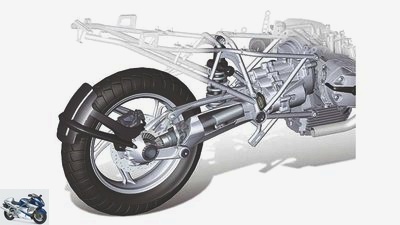
41/71
The double-joint (Paralever) swing arm was already available in 1987 in the second generation of GS, it suppresses annoying load change reactions.

Gutsche
42/71
1975: Rudiger Gutsche, Dolomites rally enthusiast and later G / S project manager, builds an agile BMW enduro with a 19-inch front wheel
and short swing arm.
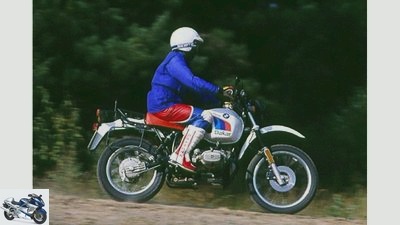
43/71
The lavishly equipped special model won numerous comparative tests.
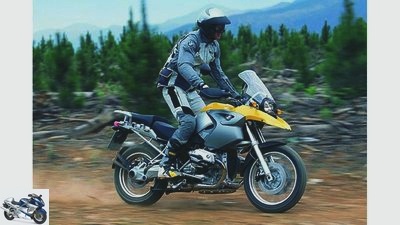
BMW
44/71
In 2004 the 1200 comes onto the market.

BMW
45/71
Here Gaston Rahier (right) and Hubert Auriol after Rahier’s Dakar victory in 1984.
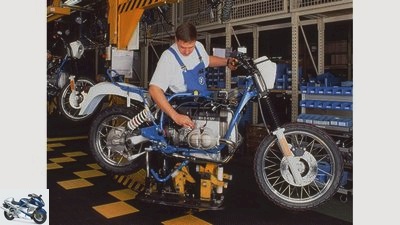
BMW
46/71
1996: Production of the Basic in the BMW motorcycle factory in Berlin.
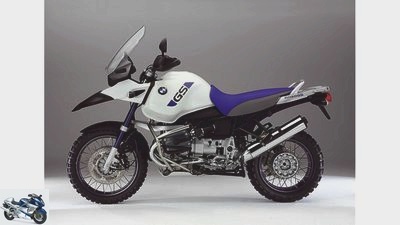
BMW
47/71
2005: To mark the 25th anniversary of the GS, BMW launched a special series of the R 1150 GS Adventure. In the coming year, the big Adventure will also get the new 1200 boxer.
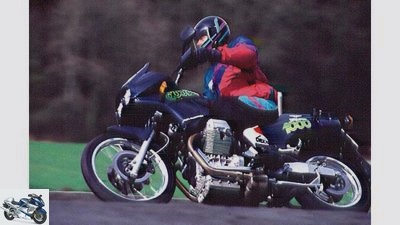
duke
48/71
1992: Actually a similar concept to the GS, but hardly anyone wants the Moto Guzzi Quota despite studded tires, 1000 V2 and cardan drive. Too bulky, too heavy, too little dynamic.

Laverda
49/71
1977: Laverda produced some prototypes with a light special frame, Marzocchi telescopic fork and central spring strut on behalf of BMW, here a test vehicle with an R 60/7 engine.
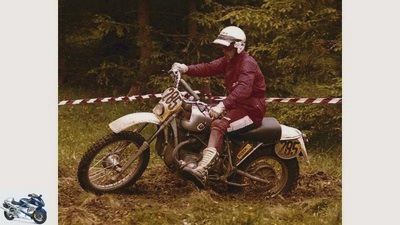
BMW
50/71
From the test department to the start: Laszlo Peres and its prototype with an 800 engine based on the R 65.
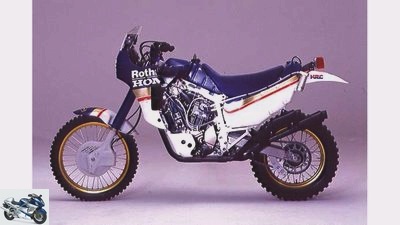
Honda
51/71
1986: Big hit from Japan. Honda announces a replica of the Paris-Dakar winning machines NXR 750 owned by Cyril Neveu and Gilles Lalay. However, it does not come, instead the less sporty Africa Twin only comes in 1988.
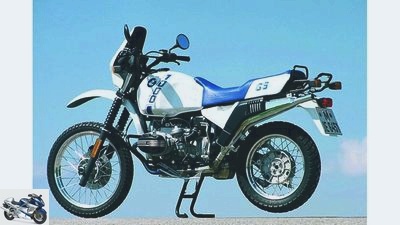
52/71
That also means more power and a more pleasing design.
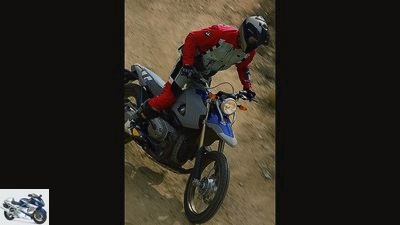
BMW
53/71
Brand new: Exclusive athlete HP2.
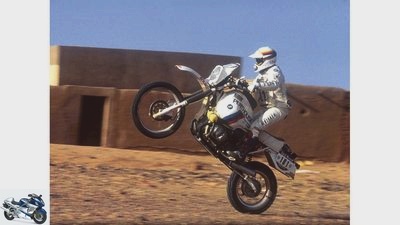
BMW
54/71
Rahier on the road at the Paris-Dakar.
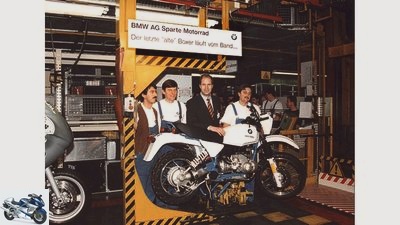
BMW
55/71
1996: The last R 80 GS rolls off the production line in Spandau, an R 80 GS Basic. Remaining stocks are still being offered in South Africa from 1997 onwards? as
R 80 GS Kalahari with 35 liter tank.
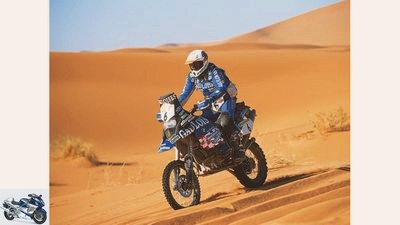
BMW
56/71
John Deacon on the R 900 RR at the 2001 Dakar.

57/71
The duckbill design is a shock to many GS fans.
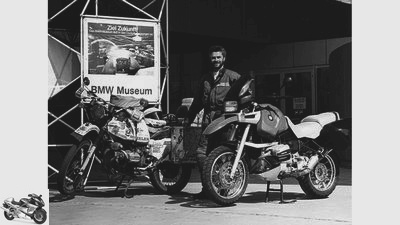
BMW
58/71
1981: Helge Pedersen, photographer and globetrotter, starts on his R 80 G / S ?? Olga ?? to orbit the earth. After 350,000 kilometers in ten years, the Norwegian will later put his bike in a museum.
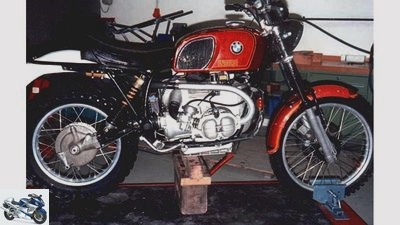
Gutsche
59/71
Test vehicle: the "Red Devil", already with single-sided swing arm and strut moved to the right.

BMW
60/71
But many R 100 GS were susceptible to the cardan shaft and gearbox.
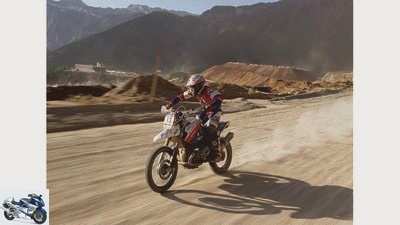
BMW
61/71
One of the first races: Jimmy Lewis at the Erzberg Rodeo in 2005.
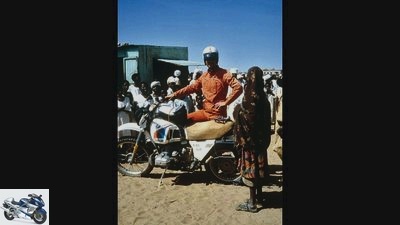
BMW
62/71
R 80 G / S at the Paris-Dakar.
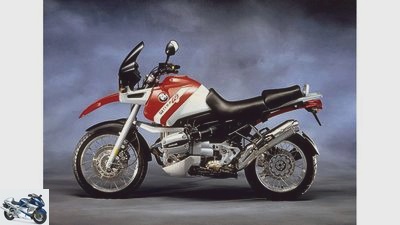
BMW
63/71
R 1100 GS.
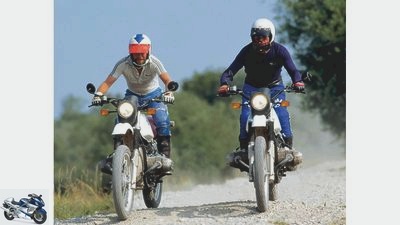
BMW
64/71
This photo documents contemporary fashion when it comes to wearing protective glasses.
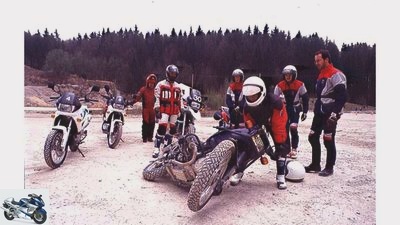
Enzmann
65/71
1995: Practice area for offside drifters. The BMW Enduro Park Hechlingen opens in the middle of the Altmuhltal Nature Park ?? with steep driveways, a water passage and a desert sand passage .
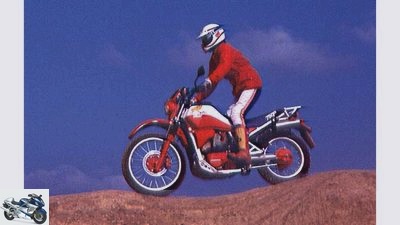
duke
66/71
1983: G / S receives Japanese competition, Honda introduces the XLV 750 R. A 61 hp cardan enduro with a weight of 220 kilograms and a massive frame made of square profiles.
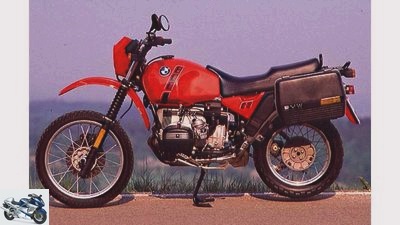
duke
67/71
1987: G / S becomes GS. Paralever and Marzocchi telescopic fork on the second GS generation.
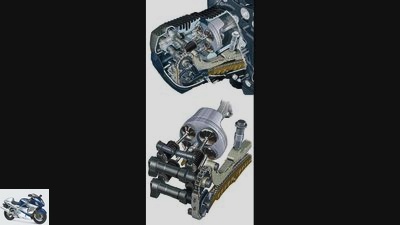
68/71
The new design with four radially arranged valves and two overhead camshafts enables higher speeds, more efficient cam profiles and more power.
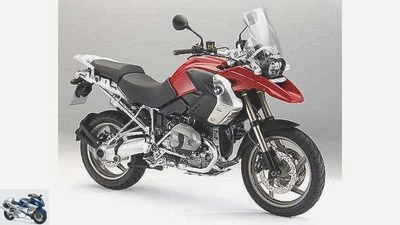
69/71
New for 2010: BMW R 1200 GS. From the 2010 model year, the GS and GS Adventure will receive the new double-cam boxer. Data: two-cylinder four-stroke boxer engine, bore / stroke 101/73 mm, 1170 cm³, 81 kW (110 PS) at 7750 / min, 120 Nm at 6000 / min.
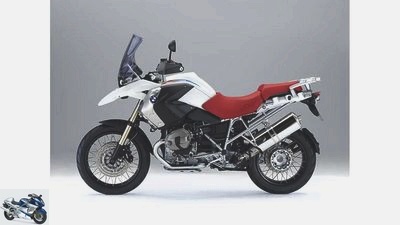
BMW
70/71
Anniversary model 2010: The special model of the BMW R 1200 GS for the thirtieth anniversary of the GS series offers its crew no red carpet, but a red bench. The cross-spoke wheels allow tubeless tires to be fitted and are more elastic than cast wheels. Good for driving on rough slopes, as the author once discovered in view of a GS cast wheel that was bent without falling.
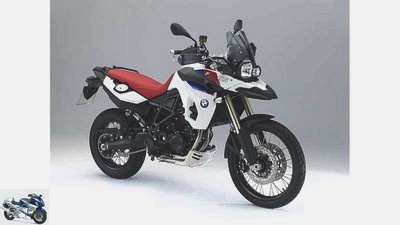
BMW
71/71
Anniversary F 800 GS: The BMW F 800 GS, which is a little closer to the original than the R 1200 GS, is also available in the special edition for an extra charge of 550 euros. If you look closely at the aluminum tub to protect the engine, you will understand part of the additional price, the rest goes to the hand guards, the paintwork and the windshield.
On the move: 30 years of the BMW GS series
The R 80 G / S and the R 1200 GS in direct comparison
Content of
Hardly anyone would have dreamed of the success story of the BMW GS series 30 years ago, not even their fathers. MOTORRAD-CLASSIC spans an arc from the BMW R 80 G / S to the current R 1200 GS and compares the two concepts.
For years, the GS model series has not only topped the BMW-internal hit list of sales figures, but also the German registration statistics. It was precisely this type of motorcycle that the motorcycle executives at BMW did not want at all in the mid-1970s. In October 1978, however, the motorcycle management team had to leave; in the same year off-road sport launched a class over 750 cm³. Then the boardroom gave the green light: the idea for a BMW enduro quickly took on concrete shape. BMW test man Laslo Perez tried out a machine in a competition, and within 21 months the new R 80 G / S was created under development chief Richard Heydenreich.
D.he prototype had such remarkable details as a single swing arm and – a first for BMW – coated aluminum cylinders. A reinforced engine housing, a lighter clutch and a contactless ignition system should improve reliability and engine characteristics. The frame corresponded to the chassis of the / 7 series except for minor changes. A 21-inch front wheel and the 18-inch rear wheel on enduro tires specially developed by Metzeler, the high front fender, a small lamp with fairing, the new, red seat and, last but not least, the high-level exhaust, initially in black, gave the G / S the sporty off-road look.
At the presentation, the marketing department in Munich sharpened the image of the big enduro: “G / S stands for terrain like street” and added a flowery: “The G / S is a universally usable leisure device for new forms of experience” – obviously to meet expectations of off-road suitability not to screw up too high and win the touring clientele for the G / S. With this characterization, the marketing strategists seemed to have hit the mark. MOTORRAD promptly titled the first driving report in issue 17/1980: “The best street motorcycle that BMW ever built.” From the excellent seating position to the manageable handling – “It swings from right to left as light as a feather, the curves are taken with rare ease” – The testers were pleasantly surprised by the comfortable chassis tuning and driving stability. One of the few points that received massive criticism was the moderate braking effect of the single disc in the front wheel: “The single-disc system needs brutal grip, the braking points are chosen a little earlier.” In off-road use, there was unadulterated joy: “The R 80 does it relatively light, like a mountain goat it climbs up a steep, scree-laden ascent. ”Rolf Witthoft proved his assessment of the off-road capability of the two-cylinder boxer with the European championship title in 1980. The Enduro left nothing to be desired on unpaved roads and in easy terrain.
duke
Angled streets and curves are the preferred area for the R 80 G / S.
Customers saw G / S as a motorhome for every use, not so much a device for off-road experts. The then largest enduro on the market was to sell so well that BMW continued to develop the series and, over the years, brought GS boxers from 650 to 1200 cm³ in all possible variants onto the market. Today the R 80 G / S is facing its latest successor, the R 1200 GS, for direct comparison. What does 30 years of progress look like and how does it feel??
First of all, the huge differences in size catch the eye: the R 80 G / S from MOTORRAD CLASSIC employee Jurgen Noll, who once rode motorcycle veteran Karl Reese as the first owner, is simple, almost slim. In addition, the enormous dimensions of the R 1200 GS easily overshadow the original meter in the truest sense of the word. The R 1200 GS appears huge from every perspective; with cases and top case, it towers over the R 80 G / S by a long way. The adjustable window, the high tank, the voluminous exhaust system as well as the massive Telelever and Paralever wheel suspensions with massive cast wheels inspire awe: A large, heavy motorcycle wants to be conquered here. In direct comparison, the R 80 G / S appears downright filigree on its spoked wheels.
These are also available for the current 1200 series, but only at an additional cost. The 1200 looks at least one and a half times as heavy as the G / S, but the scales put the impression into perspective: Without a case, but with luggage rack and additional equipment such as the electronically adjustable ESA chassis and anti-lock braking system, the R 1200 GS weighs 246 kg, i.e. about a quarter more than the 196 kg heavy R 80 G / S. Their owners could initially only order the left case in the BMW accessories program because of the exhaust system on the right; later BMW also supplied a case for the right side. With the optional tachometer and timer, the cockpit is clear and tidy. The cylinder protection bars in combination with the side stand were also available ex works for an extra charge. The list of accessories for the 80s BMW is largely exhausted, there was only an optional shock absorber with expansion tank for sports use – conversion instead of ESA switching. The basic price of 8920 marks was joined by 645 marks for the special equipment.
duke
Once rolling, the R 1200 GS is also extremely curve-friendly.
For comparison: the customer had to shell out 9,320 marks for a Honda CB 900 F Bol d’Or. With a base price of 13,000 euros, the R 1200 GS is now significantly cheaper than the current Honda CBR 1000 RR for 14,990 euros. With the optional equipment of the test machine, the surcharge quickly increases by 3245 euros, and the list is far from exhausted. Accordingly, the modern cockpit has much more to offer. Switches, buttons and displays testify to the numerous additional options of the R 1200 GS. “Info”, “ASC / ABS” and “ESA” can be read on various plastic buttons, and a symbol for heated grips indicates additional comfort features, not to mention suitcases and top cases. On the other hand, things as simple as the indicator switch seem to be missing. But it is distributed over three buttons that are hidden under the handles. The new, colorful world is being received differently: superfluous Playmobil for classic fans, informative Playstation for the not always very young, but always dynamic GS driver. The driving impression is also very different, from the moment you get on: you just step on the old G / S and sit down; the new one has to be laboriously climbed, is enthroned high above, and drivers who are not blessed with a standard can only balance it on tiptoe.
Even when stationary, the two motorcycles reveal completely different feelings and perspectives. The sitting posture is similarly comfortable behind the wide handlebars, but even slightly more relaxed on the 1200 with less bent legs. But the first meter of shunting reveals huge differences: the G / S is extremely handy and can be turned in no time. The 1200er struggles as hard as possible, which is not only due to the higher weight, but also to the high-positioned handlebars, which on top of that allow considerably less impact.
The situation is put into perspective when driving: Regardless of whether sharp corners or faster curves are to be mastered, the G / S swings easily around bends of all kinds. The 1200 also surprises with a handiness and neutrality that the G / S only has in tight corners is inferior at low speeds. At higher speeds, it shows superior driving stability even in undulating motorway bends, which is far superior to that of the classic. At the time, it was considered to be comparatively stable, but the current GS shows how far the standards have shifted.
The R 80 tends to oscillate in bends with bumps and at speeds above 150 km / h; 30 years of development cannot be denied. Especially not with the brakes: If the single disc in the front wheel of the G / S is always trying hard, even when the lever is pulled hard, the current double disc requires the least amount of manual force to apply the brake perfectly and to apply the GS at the highest level in all situations delay. If necessary, the ABS provides extremely helpful assistance and demonstrates perhaps the greatest progress.
BMW R 80 G / S and BMW R 1200 GS: Part 2
duke
Father and son: BMW R 80 G / S and BMW R 1200 GS.
The same naturally applies to the drive. The bumper-controlled two-valve engine of yore unfolds its power fairly evenly, but no longer looks stunningly dynamic today. The boxer turns more cautiously against its limit at 7000 rpm. The cardan drive ensures the familiar, distinctive elevator effect of the rear with every acceleration process.
One and a half times as much displacement, significantly more than twice the power, far greater freedom of rotation thanks to two overhead camshafts and four radially arranged valves inevitably result in different performance levels in the R 1200 GS. But they can also be controlled at any time. In the lower speed range, the large-volume two-cylinder does not have a sensationally high torque, but also shines with even power delivery and turns far more willingly towards its limit of 9000 rpm. As the engine speed rises, the exhaust gives off a hard, sporty, pithy sound of a two-cylinder synchronous machine. In contrast, the R 80 G / S hums sonically upright, almost cautious. In return, the 800 engine already causes significant vibrations in the handlebars and footrests at 2000 rpm.
On the 1200, a slight tingling sensation testifies to the turbulent events in the engine only at much higher speeds. In order to move forward quickly, the six-speed transmission wants to be tried. It shifts much easier, more directly and more precisely than the old five-speed box, but still not completely silent. Even today, the technicians have not been able to get rid of the audible “click-clack” when changing gears. The lifting figure when accelerating is a thing of the past thanks to Paralever, as is the braking nod of the telescopic fork thanks to Telelever.
In a direct driving comparison, the modern chassis with its sensitive response behavior – it only does not absorb rough bumps perfectly – leaves an incomparably quieter, more comfortable impression with considerably less intrinsic movements in all situations, from powerful acceleration to hard braking. In conjunction with the engine, which is vastly superior in terms of performance, the R 1200 GS impressively demonstrates 30 years of development.
duke
The BMW, a being like you and me: in 30 years, some people will not only have a lot of fat around their hips.
But it is not superior in every discipline, for example when it comes to wind protection: Either the adjustable windshield is deliberately designed to give drivers of all sizes an anachronistic wind face feeling in every position and at every speed from country road speeds. Or it is a faulty design that causes unpleasant turbulence and noise in the helmet area. The unimpeded, laminar flow on the R 80 G / S feels much more pleasant. The noise level is only acceptable when the driver crouches tightly behind the raised window; the posture on the wide handlebars no longer. Longer motorway journeys can only be endured with earplugs. Fortunately, accessory manufacturers are successfully plowing this field; Even one or two BMW dealers equip their demonstration motorcycle with a windshield from the accessories sector.
Another annoyance is the activation of the blinkers. Why three buttons are required for a function will elude human logic forever; at best one can get used to it. After all, BMW is now using a single switch on other models that works exactly like the one on the R 80 G / S.
The classic can also boast one more plus for itself: it can be managed much more easily and safely in light terrain over hill and dale and in tight turning maneuvers than the new design, even if it shines on unpaved gravel paths with perfect straight-line stability. The extra weight cannot be magically removed. The 1200 requires more experience to cope with moderately difficult terrain; Off-road professionals are in demand.
In 30 years of further development, not only technical aspects play a role, but also the change in the buyer’s philosophy. Perhaps that is precisely why the GS series has been subject to a constant change from the puristic enduro to the touring motorcycle over the course of three decades. Although BMW has excellent tourers with perfect wind protection in its range, there also seems to be a need for motorcycles with an adventurous aura: The hardened globetrotter, used to stress and privation, is more likely to be on the bench of a GS than behind the full fairing of an RT, even if he is not traveling across the Sahara, but only to Wehr to see Aunt Sarah. The R 1200 GS rider obviously does not miss the down-to-earth clarity of the original G / S.
In return, the purist of yore asks about the benefits and the need for lush dimensions, an infotainment system or an adjustable chassis, the function of which in the GS is not even really convincing. He might want a GS with the engine and chassis from 2010 and the dimensions and weight of the original version.
At least when it comes to weight, this wish is not a utopia; BMW did it in 2008 with the Enduro HP2. With a full tank, it weighs 198 kilograms, only slightly more than the R 80 G / S. The progress of the R 1200 GS compared to the R 80 G / S is impressive in most of the criteria, but the ancestor also demonstrates that 30 years of development does not mean radical improvements in all essential points and that fashion trends can sometimes be counterproductive.
BMW R 80 G / S
duke
The crash bars cost extra and included the side stand. The oil pan protection was part of the standard equipment.
| engine | |
| design type | Air-cooled two-cylinder four-stroke boxer engine, an underlying camshaft, two valves per cylinder, bumpers, rocker arms | drilling | 84.8 mm |
| Hub | 70.6 mm | Displacement | 797 cm3 |
| compression | 08:01 | power | 50 hp at 6500 rpm |
| Mixture preparation | Constant pressure carburetor, Bing, Ø 32 mm |
| Electrical system | starter | Kick starter, electric starter |
| battery | 12 V / 16 Ah | ignition | Battery ignition, contactless |
| alternator | Alternating current, 280 W. |
| Power transmission | coupling | Single disc dry |
| transmission | Five-speed, claw shift | Secondary drive | Cardan |
| landing gear | |
| Frame type | Double loop frame made of tubular steel | Front wheel guide | Telescopic fork |
| Rear wheel guide | Single-sided swing arm made of tubular steel, mono spring strut, directly hinged | bikes | Wire spoke wheels |
| Front tires | 3.00 – 21 | Rear tire | 4.00 – 18 |
| Front brake | Single disc, Ø 260 mm, two-piston fixed caliper | rear brake | Simplex drum brake, Ø 200 mm |
| mass and weight | |
| Weight | 196 kg | wheelbase | 1465 mm |
| Tank capacity | 19.8 liters |
| Performance | Top speed | 173 km / h |
| price | 8920 marks (1980) |
| Manufacturer | BMW AG, Munich, Germany |
BMW R 1200 GS
duke
Lambda sensors in each of the two exhaust manifolds regulate the mixture composition for clean exhaust gases.
| engine | |
| design type | Air-cooled two-cylinder four-stroke boxer engine, two overhead camshafts, four radially arranged valves per cylinder, rocker arms | drilling | 101 mm |
| Hub | 73 mm | Displacement | 1170 cm3 |
| compression | 11.5: 1 | power | 110 hp at 7750 rpm |
| Mixture preparation | electronic injection, Ø 50 mm |
| Electrical system | starter | Electric starter |
| battery | 12 V / 14 Ah | ignition | electronic ignition, contactless |
| alternator | Three-phase current, 720 W. |
| Power transmission | coupling | Single disc dry |
| transmission | Six-speed, claw shift | Secondary drive | Cardan |
| landing gear | |
| Frame type | Tubular steel frame, load-bearing engine-gear unit | Front wheel guide | Trailing arm guided telescopic fork, Telelever |
| Rear wheel guide | Double-jointed single-sided swing arm, Paralever, suspension strut with lever deflection | bikes | Cast wheels |
| Front tires | 110/80 R 19 | Rear tire | 150/70 R 17 |
| Front brake | Double disc, Ø 305 mm, four-piston fixed calipers | rear brake | Disc, Ø 265 mm, two-piston fixed caliper |
| mass and weight | |
| Weight | 246 kg | wheelbase | 1507 mm |
| Tank capacity | 20.0 liters |
| Performance | Top speed | 215 km / h |
| price | 13,000 euros |
| Manufacturer | BMW AG, Munich, Germany |
Opinion BMW R 80 G / S versus R 1200 GS
duke
The owner of the BMW R 80 G / S Jurgen Nolls.
Jurgen Noll’s youngest motorcycle and at the same time the most powerful one he has ever driven is our photo model, the R 80 G / S. Now he draws a comparison with the R 1200 GS.
What a monster! I am now supposed to test drive this aggressive-looking animal. The basic concept – air-cooled two-cylinder boxer, cardan, tubular frame – has remained. When I sit on it, the first surprise: I actually just sit on my old one, the new one wants to be climbed. The raised passenger seat doesn’t make things any easier. When you finally sit behind the handlebars, most things seem familiar; Speedometer, rev counter, control lever – and a mysterious display. Switch on the ignition, press the starter button on the right – like the old one. What should one improve there??
The sound is completely strange. Hearty, dry – very beautiful. Clutch and gear shift work precisely and smoothly. The acoustic feedback of the gear change is still there, but much more subtle than before and hardly disturbing. How do you actually operate the turn signal? Ah yes: on the left handlebar is the button for “left indicator”, on the right the one for “right indicator” and next to it the third one for “indicator off”. It is particularly uncomfortable that after turning off I press the throttle with my thumb while looking, which the GS acknowledges with a leap forward. That’s better about my old woman: One switch for everything.
On the country road, the new one shows itself from its best side: briskly pulled on the cable, the GS rises from the springs and storms forward. With the old 800 bumper motor, the red area starts at 7000 rpm, the dohc 1200 turns well and likes 2000 rpm higher. Then a whopping 110 hp are available. However, the GS has also become 50 kg heavier. After driving three kilometers, the pounds are forgotten; they only become a nuisance again when turning on a narrow road or a dirt road. The double disc brake earns top marks for this.
The chassis of the original G / S was already considered to be very good at the time, the new one seems to me to be the ultimate. No load change reactions from the cardan, and the front fork is a dream. I’m looking for potholes, bumps, manhole covers – but nothing disturbs the 1200s even remotely. At the latest with the longitudinal grooves in the asphalt, my G / S would begin to waggle. For the newbie, these grooves don’t seem to exist at all. I hardly see any differences between the “Comfort” and “Sport” suspension settings that can be called up at the push of a button.
When I get off, I notice the exhaust flap in the area of the manifold. Motorcycles had something similar 100 years ago: the so-called chicken flaps. Open when driving overland, they should scare away poultry and dogs. Today they optimize the noise levels in the approval process and are no longer controlled manually, but electronically.
The original G / S has found a worthy successor in the R 1200 GS, which, as expected, has been improved in almost all areas. Slimmed down to the weight of 30 years ago, with a lower seating position and only one indicator switch instead of three, I could make friends with her.
Related articles
-
Spotlight: 30 years of the BMW R 80 G-S
Jahn 71 pictures BMW 1/71 1985: Little Gaston Rahier fights his way through the desert again with his huge HPN boxer and can win his title at the …
-
On the move: the BMW GS conversion by BMW developer Laszlo Peres
Jahn On the move: BMW GS conversion The BMW GS from BMW developer Laszlo Peres Content of Former BMW developer and off-road specialist Laszlo Peres gets…
-
On the move: the Honda VF 500 F II and Yamaha RD 500 LC
fact On the move: Honda VF 500 F II and Yamaha RD 500 LC Extreme athletes Contents from the beginning of 1984, the Honda VF 500 F II and Yamaha RD 500 LC …
-
On the move with the Honda XL 600 V Transalp
Volker Rost 26 pictures Volker Rost 1/26 Honda XL 600 V Transalp. Volker Rost 2/26 Honda had not had any luck with two-cylinder enduros until then. People…
-
Comparative test of BMW GS models
fact comparison test BMW GS models GS summiteers The GS models from BMW are bestsellers, all-rounders and image carriers. You can travel with them …
-
Technology 20 years of progress in motorcycle construction: Honda Fireblade – old against new
fact 14th photos fact 1/14 At the end of 1991 Honda presented the first Fireblade and shook the athlete Olympus permanently. We compare the Fireblade SC…
-
Siemer On the move: Moto Guzzi V7 steam announcement Contents of No teeth in the mouth, but La Paloma whistle: This is how it looked when Moto Guzzi despite the highest …
-
On the move with six motorcycle icons of the 70s
fact 33 pictures fact 1/33 wobbly candidate: When there is wind, working with such a large brightener is not entirely without it. fact 2/33 Six correct ones: The …
-
On the move: BMW R 100 S, Honda CB 900 F Bol d’Or, Moto Guzzi Le Mans I.
fact On the move: big bikes from the 70s BMW R 100 S, Honda CB 900 F Bol d’Or, Moto Guzzi Le Mans I. Content of At the turn of the decade, MOTORRAD…
-
On the move with Majestic 350 from 1930 and Bimota Tesi 1D-SR from 1992
41 pictures r-photography.info 1/41 picture gallery: Majestic 350 from 1930, Bimota Tesi 1D / SR from 1992. r-photography.info 2/41 The …